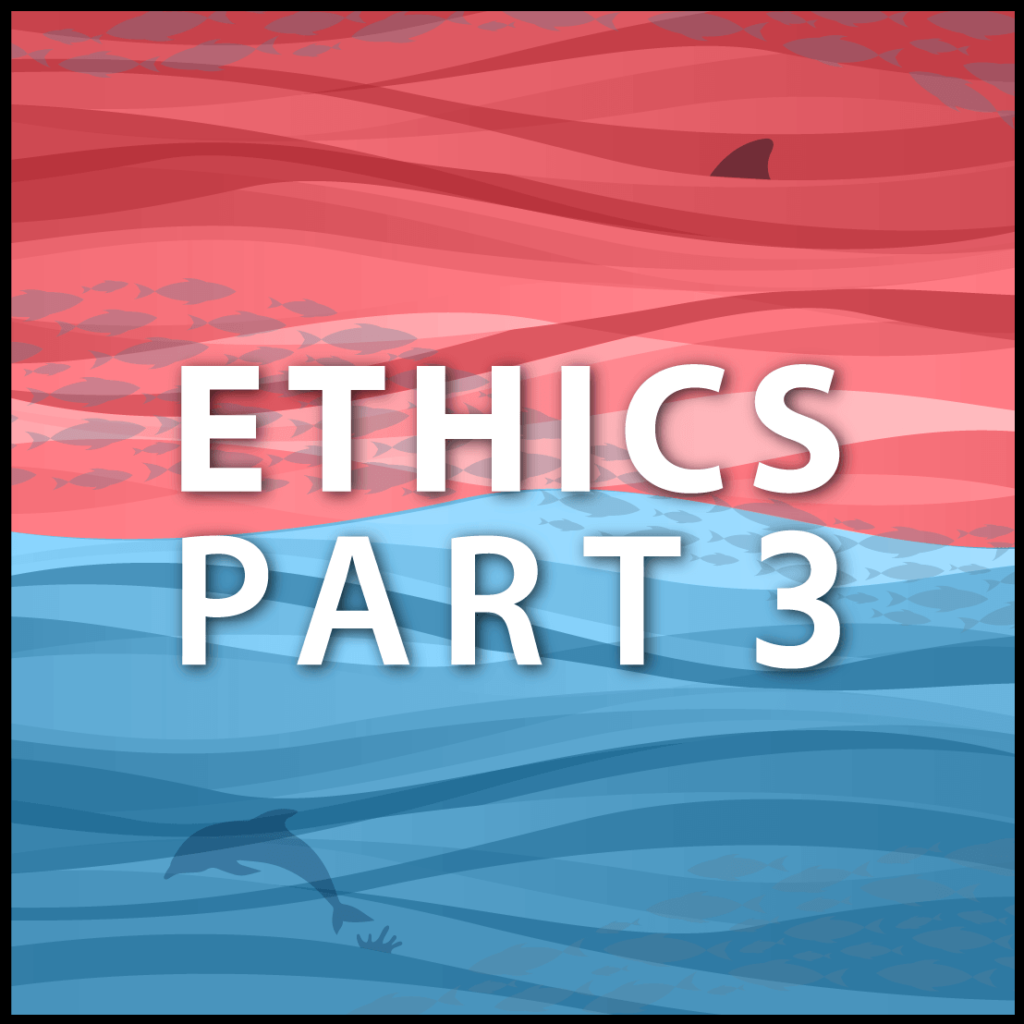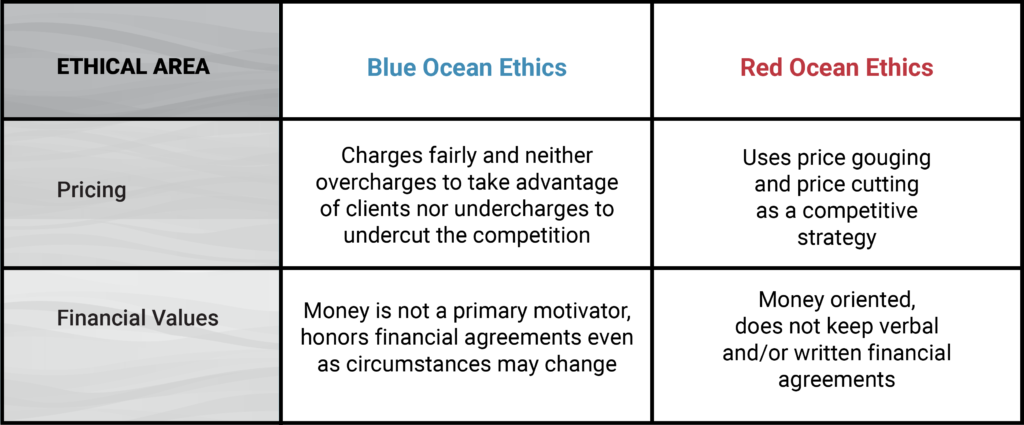
An Enneagram in Business (EIBN) requirement is that all network members adhere to Blue Ocean ethics in order to maintain integrity and build trust among one another and with clients. These ethical guidelines, which I created, include the accurate representation of background and services; respect for intellectual property; open information and idea sharing; fair pricing; honoring agreements; an abundance rather than scarcity orientation; and respect for clients, collaborators and competitors.
Red Ocean Ethics: Individuals who use Red Ocean guidelines beat the competition using existing rules of competition and trading off between diversification (differentiation) of products, services, and cost.
Blue Ocean Ethics: Individuals who use Blue Ocean guidelines leverage untapped market space, expand existing industry boundaries, and/or move outside existing industry boundaries.
The translation of Blue Ocean guidelines from organizational use to individual practice has 10 areas; this blog reviews two more of the 10, with earlier blogs having covered four topics and the remaining blogs to cover four additional areas. Thus far, values related to professional self-presentation, intellectual property, sharing of information, and competitive orientation have all been described. Now, the focus is financial.

Pricing
Once upon a time, early in my consulting career some 45 years ago, my then-mentor Alice Sargent gave some compelling words of wisdom to the young consultant who was me. Alice said, “There’s what you could charge and then there’s what your conscience can bear.” This stuck with me all these years as I think about how I price my work, and also when I offer advice to others who ask for it.
How often do people in training, coaching or consulting actually share what they charge for their services, their clients being the exception because clients have to know your fees? This is also true in the Enneagram world. How many Enneagram teachers know what other Enneagram teachers charge? How many Enneagram coaches know what other Enneagram coaches charge? People just don’t talk about money. In addition, there are so many variables involved in determining fees so it gets complicated. Variables include the books you’ve written; years of experience; reputation, region, educational or professional background, and more. There’s also the marketplace. And then there’s your conscience.
In general, I charge slightly above mid-range and keep my fees constant – that is, non-negotiable – unless it is for government or non-profits. I even do some work free. And I never underprice my work so that the client will hire me rather than someone else. I also do not intentionally over-price my work. Once a new client from an organization where I was already working requested some work and asked for my fees. I told them, but this new client misheard what I said and heard it as double what my fees actually are. Moreover, they were willing to pay the high rate. But my conscience would not allow this. It is price gouging.
In the Blue Ocean, under-pricing to beat a competitor or over-pricing, just because you can, are not aligned with Blue Ocean values. Yes, fair pricing is a Blue Ocean value. But in Blue Ocean strategy, fair pricing is also smart. There’s no need to under-price to get work because there are other customers to pursue who may not use your goods and services now, but who will want to do so because of the value you add. There’s no need to over-price because, in Blue Ocean strategy, you increase your customer base by proving more value to them at a lesser cost to you.
Why do people charge so much or so little?
I think there may be several factors involved. First, people may not know they are under- or over-pricing. As such, pricing this way is not Red Ocean pricing; it is simply lack of knowledge. Lack of information can be addressed easily; ask people you know what they charge, why and how well this is working for them.
The other key factor involved in under- or over-pricing is the association of one’s worth or value with how much they charge. On one hand, I know many people who dramatically under-charge because they are not sure what they offer is worth a higher price. When people ask me about pricing and I hear that their pricing is way below market, I ask them how much they think they are worth and why. When I suggest that their fees are too low, I ask them how much more they could charge and still be comfortable with this higher fee. If it is still very low, I challenge them, in a supportive way, making the case that if the charge is too low relative to other professionals, some clients will not hire a trainer, coach, or consultant who is too low priced because the client thinks that person may not be high quality enough.
On the other hand, there are people who charge as much as they can get, thinking, why not? Or, in some cases, people may over-value themselves and what they offer and then charge extremely high prices. Over time, clients figure out that they are being over-charged and that the over-charger is functioning in a Red Ocean manner. Most clients, not all, would prefer to work with an Enneagram professional who swims in the Blue Ocean and not the Red.
Financial Values
Pricing and financial values are interconnected. People who are primarily financially motivated generally tend to be more Red Ocean in orientation; their behavior is driven by money and its accumulation. In the Blue Ocean, professionals acknowledge that money is a resource that enables them to do other things – for example, expand their business, live a life without financial stress, contribute to their community either financially or via volunteerism. Money, however, is not their only motivator or even their prime motivator. More often, fame and power also go with Red Ocean; contribution, elevation of consciousness and sustainability align with Blue Ocean.
What drives you, really?
I often say that most people talk about themselves as either the heroes of their own stories or as the victims of someone else’s poor behavior. This suggests that there are very few, if any, perpetrators out there. Are we all heroes and/or victims? It is in the Red Ocean where heroes and victims live. In the Red Ocean, there is an sense of “agency” or responsibility outside themselves: “I do this because you do that (or might do that).” In the Blue Ocean, “agency” is more internal, where there is more honest self-reflection and far greater responsibility for drives and subsequent behaviors.
So what really drives us? If we think it is not money, but it is fame, power or influence, money is not far behind. Or perhaps we think we are driven by a need for respect, but do we associate making money with respect. Is a need for being big somehow linked to our drive for money? Is our need for freedom linked to money, and so we may not think we are money driven, yet we are?
Blue Ocean Summary
These are sensitive topics, offered here to encourage self-reflection on a deeper level. The Blue Ocean provides a context in which to do exactly that!
Ginger Lapid-Bogda PhD, the author of seven Enneagram-business books, is a speaker, consultant, trainer, and coach. She provides certification programs and training tools for business professionals around the world who want to bring the Enneagram into organizations with high-impact business applications, and is past-president of the International Enneagram Association. Visit: TheEnneagramInBusiness.com | ginger@theenneagraminbusiness.com

Comments are closed.